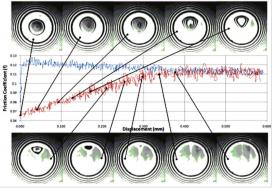Rheology of High Pressure Fluid Films May Improve the Performance of Hydraulic Systems
Researchers at the Center for Compact and Efficient Fluid Power (CCEFP), an NSF-funded Engineering Research Center (ERC) headquartered at the University of Minnesota, have discovered that highly pressurized oil entrapments can reduce start-up friction in hydraulic systems by about 50 percent. The discovery offers new insights into how entrapments may be used to improve the performance of hydraulic motors.
Certain hydraulic motors are sized larger than is necessary for steady operation because of the need to overcome start-up friction. Larger motor size also results in greater costs and decreased efficiency. The work of researchers at the CCEFP is increasing understanding of friction in high-pressure contacts, improving modeling capabilities, and pointing toward practical applications that could lead to lower equipment and fuel costs while further increasing efficiency.
Participants in the CCEFP research team observed that dimples filled with highly pressurized oil, known as elastohydrodynamic lubrication entrapments, appear in the contacts between components made of hardened steel following a sudden halt to a rolling or sliding motion or after an impact. The team hypothesized that these entrapments may support a significant portion of hydraulic contact loads and could thus reduce startup friction by providing less resistance to sliding for a portion of the contact area. To test their hypotheses, a specialized rig was constructed to slide a sapphire plate against a hardened steel ball. In some tests, an entrapment was formed between the ball and plate. The friction at the start of sliding was measured and the tests with an entrapment were compared to those without.
In cooperation with colleagues from eight laboratories in five countries, this team has been able to accurately calculate friction of a high-pressure, sliding contact in the thermal regime from the measurable properties of the liquid. This required a correlation of the transport properties of the liquid, viscosity, and thermal properties with respect to temperature and pressure. The viscosity of five very different liquids—dimethyl pentane, a fuel; propylene carbonate, a solvent; decamethyl tetrasiloxane, a silicone oil; squalane, a hydrocarbon oil; and diisodecyl phthalate, a diester oil—were measured for temperatures to 150 degrees Celsius (C) and pressures to 1.2 gigapascal (GPa) (175,000 psi). A single relation, plotted as a curve, describes the viscosity of all materials at all conditions with a standard deviation of relative viscosity of 16 percent.
As a result of these studies, researchers devised a framework for thermodynamic scaling of transport properties of liquids that combines the temperature and pressure dependence into a single parameter. This framework is being used in friction calculations. A new normalization of the scaling parameter for viscosity provides a single equation to describe behavior over a broad range of temperature and pressure that previously required two different forms of the free volume relation. The new equation should be superior for extrapolation to extremes of temperature and pressure.


